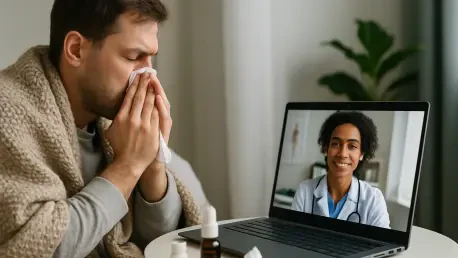In the heart of Garland, Texas, a quiet revolution in healthcare is unfolding as flu season looms on the horizon, bringing with it the usual challenges of packed waiting rooms and strained medical facilities, but now, local families are finding relief through a groundbreaking telehealth program. With the introduction of TAP Telehealth by MD Health Pathways, approved by the Garland City Council, residents can connect with licensed doctors and nurses through secure virtual visits, offering a faster and more affordable alternative to traditional care. As flu activity in North Texas typically spikes between October and February, the timing of this program couldn’t be more critical. It addresses the overwhelming demand on clinics and hospitals during peak times, promising to redefine how medical care is accessed in the community. This development not only highlights Garland’s innovative spirit but also sets a potential blueprint for other cities grappling with similar healthcare challenges.
A Timely Solution for Flu Season Challenges
As flu season approaches each year, Garland’s healthcare facilities often face immense pressure, with emergency rooms and urgent care centers overwhelmed by patients seeking treatment for symptoms ranging from mild to severe. TAP Telehealth emerges as a vital tool in this context, providing consultations within minutes via phone, tablet, or computer, a stark contrast to the three-to-six-hour wait times commonly experienced at in-person facilities. This rapid access to care is particularly beneficial for those with mild to moderate flu symptoms who don’t require emergency attention but still need prompt medical advice. By diverting non-emergency cases to virtual platforms, the program helps alleviate the strain on local hospitals, allowing them to focus resources on critical cases. Operating daily from 8 a.m. to 10 p.m., the service covers not just flu-related concerns but also other common ailments, ensuring that residents have a reliable option for timely healthcare whenever the need arises.
Beyond the efficiency of reduced wait times, the telehealth initiative offers a layer of safety that traditional in-person visits cannot match during flu season. By enabling remote consultations, TAP Telehealth minimizes the risk of exposure to other illnesses in crowded waiting areas, a significant concern when contagious viruses are circulating widely. This feature proves especially valuable for vulnerable populations, such as seniors or individuals with limited mobility, who might otherwise face heightened risks or logistical challenges when seeking care. The platform’s HIPAA-compliant design ensures that patient privacy remains protected during virtual visits, fostering trust among users. Whether it’s a quick check on flu symptoms or a follow-up for a prescription, families can access personalized medical advice without the added worry of contracting additional infections, making healthcare both safer and more convenient in a time of heightened health risks.
Enhancing Accessibility and Community Wellness
One of the standout aspects of TAP Telehealth is its commitment to accessibility, ensuring that quality medical care reaches diverse segments of Garland’s population regardless of physical or logistical barriers. For caregivers, individuals with mobility issues, or those simply unable to travel to a clinic, the ability to consult with healthcare professionals from home is a game-changer. The program addresses a wide range of health needs beyond just flu care, including sinus infections, minor injuries, and medication inquiries, with electronic prescriptions sent directly to local pharmacies for added convenience. This comprehensive approach means that residents can manage everyday health concerns without the hassle of navigating crowded medical facilities or enduring long commutes. By breaking down these barriers, the initiative empowers families to prioritize their well-being in a way that fits seamlessly into their daily lives, reinforcing the idea that healthcare should be within everyone’s reach.
Garland’s proactive stance on community wellness is further evidenced by the strategic rollout of this telehealth program, starting with a pilot phase that grants early access to 10,000 families before a full citywide launch planned for spring 2026. The enthusiastic response to initial enrollment signals strong public interest and hints at the potential for widespread adoption across the city. Dirk Perritt, CEO of MD Health Pathways, has emphasized the importance of timely care during flu season, noting that virtual visits offer peace of mind by eliminating the need for long waits at physical locations. This initiative positions Garland as a leader in adopting technology-driven healthcare solutions, setting an example for how communities can leverage digital tools to address systemic challenges in medical access. The focus on both individual convenience and broader public health outcomes underscores a forward-thinking approach that could inspire similar efforts in other regions facing seasonal healthcare demands.
Reflecting on a Path Forward with Telehealth
Looking back, the introduction of TAP Telehealth in Garland marked a significant shift in how flu care was approached, offering a practical solution to the perennial challenges of wait times and exposure risks during peak illness seasons. The program’s success in providing rapid, secure virtual consultations demonstrated that technology could bridge critical gaps in healthcare delivery, especially for non-emergency cases that once clogged local facilities. It also highlighted the importance of safety for vulnerable groups who benefited immensely from remote access to medical advice. As the initiative gained traction, it became clear that such innovations were not just stopgap measures but foundational steps toward a more resilient healthcare system. For Garland, this was a moment of transformation, proving that community-driven solutions could have a lasting impact on public health.
Moving ahead, the focus should shift to expanding the reach and capabilities of telehealth services like TAP Telehealth, ensuring that every resident can benefit from this modern approach to care. Stakeholders might consider integrating additional features, such as multilingual support or specialized pediatric consultations, to cater to the diverse needs of the population. Partnerships with local schools and workplaces could further promote awareness and enrollment, embedding telehealth as a staple in community health strategies. As other cities observe Garland’s progress, there’s an opportunity to share best practices and adapt this model to varying local contexts, potentially reshaping healthcare access on a broader scale. Embracing continuous improvement and scalability will be key to sustaining the momentum of this digital healthcare revolution, ensuring that the benefits seen during flu season extend to year-round wellness for all.









